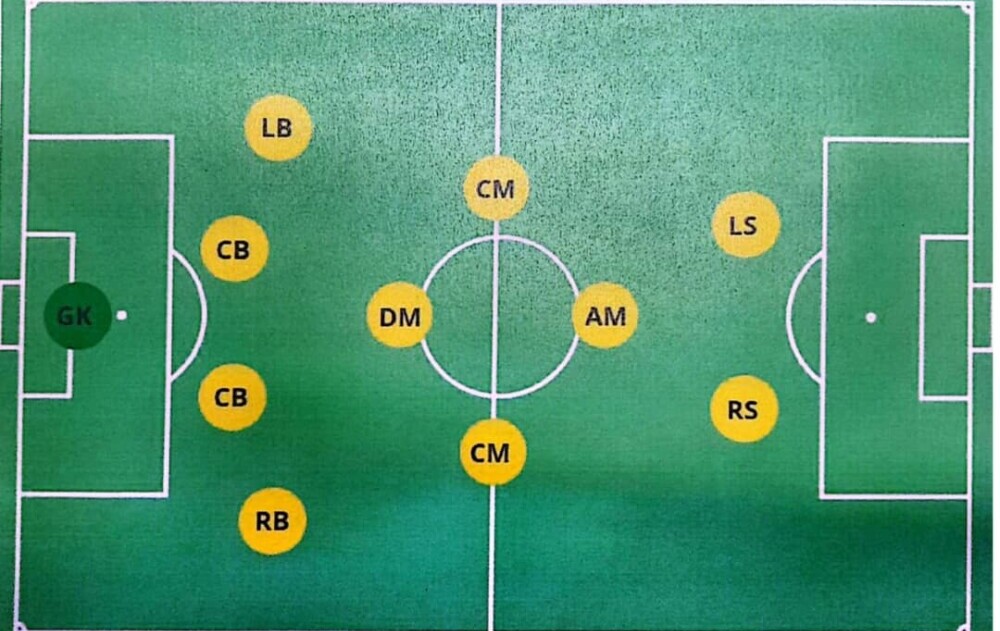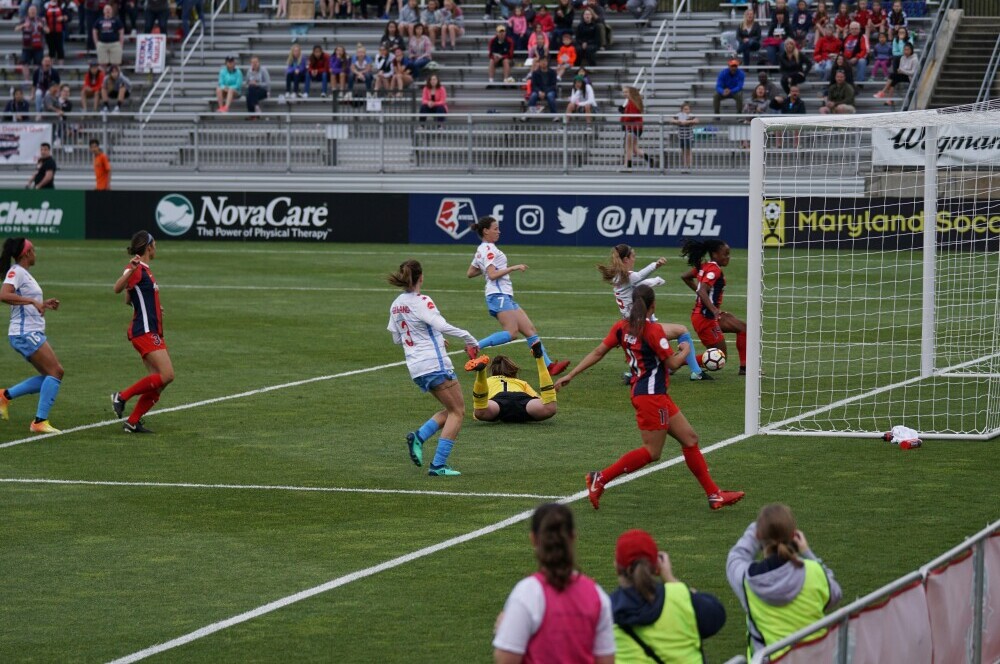The 4-4-2 formation is one of the most classic and widely used formations in soccer, admired for its balance and adaptability.
Whether you’re a beginner or an experienced coach, understanding the 4-4-2 is crucial to analyzing modern soccer tactics.
Its simplicity, versatility, and solid structure have made it a favorite choice for coaches worldwide, from grassroots to elite levels.
In this detailed breakdown, we’ll explore the components, variations, advantages, disadvantages, and tactical implications of the 4-4-2 soccer formation.
The Basic Structure of the 4-4-2 Formation
The 4-4-2 formation is primarily a defensive setup, with a strong emphasis on creating balance between offense and defense. It consists of:
- Four Defenders: Two central defenders (center-backs) and two full-backs positioned wide, who can also support the attack.
- Four Midfielders: Two central midfielders who typically manage the ball distribution and defend, and two wide midfielders who operate along the flanks, providing width to the attack.
- Two Forwards: Two strikers positioned upfront, whose primary responsibility is to score goals.
Each of these components contributes to a compact and organized structure that allows the team to defend with a solid back line while also offering options in attack.
Variations of the 4-4-2 Formation
While the basic 4-4-2 structure remains consistent, the tactical role of the players can shift depending on the strategy a coach wants to implement.
The formation has a number of variations that offer flexibility based on the opponent, the game context, or specific tactical goals:
- Defensive 4-4-2:
-
- Focus: This version emphasizes defensive solidity. The midfielders typically play deeper to provide extra protection to the defense. The full-backs often remain more conservative, limiting their forays forward.
- Objective: The goal is to remain compact, block passing lanes, and stifle the opponent’s attack. This variation is often used when a team needs to defend a lead or against a team that is superior in possession.
- Attacking 4-4-2:
-
- Focus: In this variation, the midfielders push forward to support the attack. The central midfielders will often play higher up the pitch, providing more passing options to the forwards.
- Objective: The primary aim is to create more attacking opportunities, using the width of the field. The wide midfielders (wingers) often overlap with the forwards to create an extra attacking dimension.
- Diamond 4-4-2:
-
- Focus: In the diamond variant, the two central midfielders form a diamond shape, where one midfielder plays as the holding player (defensive midfielder), the other as the playmaker (attacking midfielder). The wide midfielders play more centrally, closer to the defensive midfielder.
- Objective: This formation allows the team to control the midfield and offers flexibility in transitioning from defense to attack. The diamond shape encourages fluid movement, creativity, and more possession control.
- 4-4-2 with a Defensive Midfielder:
-
- Focus: This variation adds an extra defensive midfielder, usually positioned in front of the center-backs, providing additional security at the back.
- Objective: This setup is used to strengthen the defensive midfield and limit space for the opposing team’s attacking players. It’s particularly effective when facing strong midfield teams or trying to maintain a defensive posture.
Advantages of the 4-4-2 Formation
The 4-4-2 formation provides a number of tactical benefits that make it popular among coaches, especially at the professional and youth levels:
- Defensive Solidity:
-
- The formation’s defensive structure is well-organized, offering a reliable shape against attacks. With four defenders and four midfielders, the team can cover a wide area, making it difficult for opponents to break through. The two central midfielders also provide support for the defense, ensuring the team is well-protected.
- Balanced Attack and Defense:
-
- The 4-4-2 offers a well-balanced approach between attacking and defensive duties. With two forwards and wingers capable of joining the attack, there is always a threat going forward. At the same time, the defensive midfielders and full-backs provide the necessary stability when the team loses possession.
- Flexibility:
-
- One of the biggest advantages of the 4-4-2 formation is its flexibility. Coaches can easily modify it to meet the needs of different situations. For example, it can be adjusted into a 4-5-1 or 4-3-3 formation depending on the match’s flow or the team’s need for more defense or attack.
- Simplicity:
-
- The 4-4-2 is easy to implement and understand, making it an ideal choice for teams at all levels. Coaches can focus on developing a team’s individual skills without having to constantly worry about overly complex tactics. The simplicity of this formation is key in helping young players grasp the basic principles of positioning and teamwork.
Disadvantages of the 4-4-2 Formation
While the 4-4-2 formation is widely used, it’s not without its disadvantages:
- Lack of Creativity in Midfield:
-
- In a traditional 4-4-2, the midfield can become a battle of attrition, where teams may lack the creative players to unlock the opposition’s defense. The wide midfielders (wingers) may struggle to influence the game if they are primarily tasked with defensive duties.
- Vulnerability to Counter-Attacks:
-
- If the team presses too high or loses possession quickly, it can leave gaps in midfield and behind the strikers. The 4-4-2 doesn’t always have enough numbers in the midfield to cope with a quick counter-attacking team, especially when the wide midfielders or full-backs are caught up the field.
- Difficulty in Dominating Possession:
-
- Against teams that use formations such as 4-3-3 or 4-2-3-1, the 4-4-2 can struggle to dominate possession. The narrow central midfield can be overrun by the opposition’s midfield, leading to difficulties in controlling the game through possession.
Conclusion: How to Use the 4-4-2 Formation Effectively
The 4-4-2 formation remains a popular and effective choice in modern soccer, offering a balanced approach to both attack and defense.
Its versatility, defensive solidity, and simplicity make it a reliable system for teams at various levels.
However, coaches must be mindful of its limitations, especially regarding possession play and counter-attacks.
When used effectively, the 4-4-2 can be adapted to different tactical situations and can be combined with other formations such as the 4-3-3 or 3-5-2.
By understanding the strengths and weaknesses of the 4-4-2, coaches can make informed decisions about when and how to use it, ensuring their team has the right balance between defensive security and offensive potential.
By teaching players to recognize and adapt to different variations of the 4-4-2, teams can gain a tactical advantage that will help them succeed both defensively and offensively on the pitch.
Ultimately, the key to mastering the 4-4-2 lies in understanding its core principles and adapting them to the strengths of your players and the challenges posed by your opponents.
Lets keep the conversation going. I would love to hear your thoughts, experience and your questions. Leave them in the comment section below and I promise to reply.
Happy soccer season!!!!!!
” Here’s a little transparency: Our website contains affiliate links. This means if you click and make a purchase, we may receive a small commission. Don’t worry, there’s no extra cost to you. It’s a simple way you can support our mission to bring you quality content.”



The 4-4-2 formation has always been my go-to setup when coaching youth teams. Its balance and simplicity make it easy for players to grasp their roles while offering plenty of opportunities to adjust based on the flow of the game. One challenge I’ve faced, though, is ensuring the midfielders maintain their shape under pressure, especially against teams using a more possession-focused 4-3-3. What are your tips for keeping the midfield compact without sacrificing offensive potential? Would love to hear how others manage this!
Hi Herman
Thank you so much for your comment and for sharing your experience with the 4-4-2 formation.
I completely agree—its balance and straightforward structure make it a fantastic choice, especially for youth teams who are still developing their tactical awareness.
Maintaining midfield shape under pressure, particularly against possession-heavy formations like the 4-3-3, can definitely be a challenge. Here are a few strategies I’ve found effective:
Encourage Horizontal Compactness:
I always emphasize keeping the midfield line tight horizontally. The central midfielders should stay close to each other, shifting as a unit to cut off passing lanes. This limits the opponent’s ability to play through the middle and forces them wide, where it’s easier to apply pressure.Staggered Midfield Positions:
One midfielder can drop slightly deeper to act as a screen in front of the defense, while the other stays higher to link play with the forwards. This staggered positioning helps cover gaps while still allowing quick transitions into attack.Wingers Tracking Back:
The wide midfielders play a crucial role in providing defensive support. I encourage them to tuck in slightly when defending to add an extra layer of cover and then push forward quickly during counterattacks to maintain offensive potential.Quick Transitions:
To balance defense and attack, I often train my players to transition rapidly from defense to offense. Winning second balls and making quick passes to wide areas helps maintain compactness while creating scoring chances before the opponent can reorganize.High Press and Triggers:
Pressing high in specific moments (like poor back passes or weak touches) can disrupt possession-focused teams and allow the midfield to push up as a unit without losing structure.
It’s always a balancing act, but drilling these movements in training helps the players instinctively stay compact and disciplined without losing their attacking edge.